No products in the cart.
Drone photography has been around for a good number of years and thanks to the growing popularity of drones, user experience is about to be revolutionized. If you have spent some time looking at drone Instagram posts, you have probably come across videos and photos that seem very bold and catchy but with greater altitudes, things seem to get stale pretty fast. Well, this DJI Mavic 2 Pro review shows you how drones are here to transform this; thanks to improved image quality and a greater compositional flexibility.
The Mavic Pro might have been a revelation even though it wasn’t a perfect product.
However, it presented a new paradigm for DJI and the entire consumer drone industry in general. The fact that it was compact and could fold up into a nice portable package made it convenient to shove into a backpack and carry around on aerial adventures. It was also the start of a new line for the company that paved way for other models (Mavic Spark and Mavic Air), both of which turned out to be more portable than the predecessor.
Two years following the introduction of this flagship product, the company hasn’t touched it.
Following the postponed launch in July and an unglamorous leak in the Argos catalogue, DJI finally decided to announce the 2 drone sequels to Mavic Pro; the DJI Mavic 2 Zoom and DJI Mavic 2 Pro, arguably the most advanced drone this company, or for that matter, any other company has ever released.
If you are new to this range of drones, the Mavic Pro was a little like the drone equivalent of premium compact cameras, sitting somewhere between the point-and-shoot Spark and the larger Phantoms.
Both Mavic 2 models present something new to DJI drones for the first time. Despite being a powerful set, these drones still steal some of the original Mavic designs in many regards.
As the name suggests, the Mavic 2 Zoom comes in a foldable design with optical design with only a slightly smaller sensor as a flipside as compared to its sibling. The hobbyist-friendly Mavic Air might have stolen the thunder earlier on this year but the Mavic Pro and Pro Platinum were everyone’s favorite 4K travel drones.
So, what should we expect of the Mavic 2 Zoom and DJI Mavic 2 Pro? Will they improve from their predecessor, or will they be like just any other drone? Here is everything you may need to know:
Design
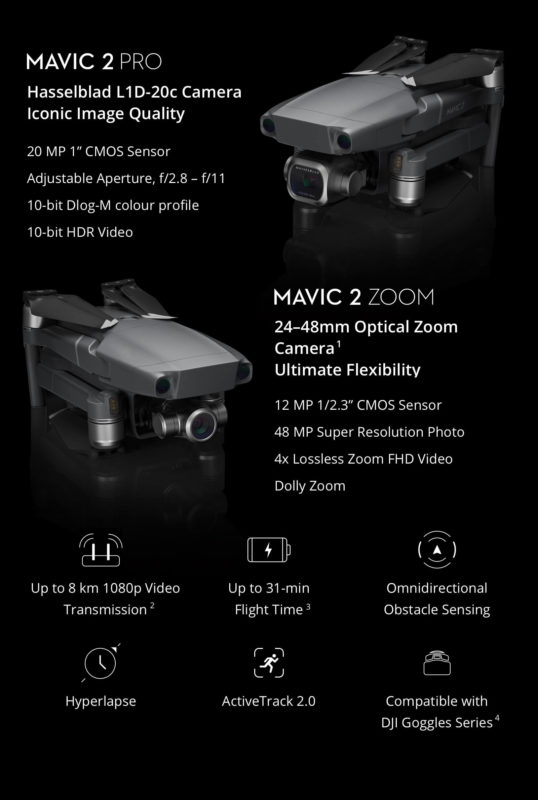
The Mavic 2s haven’t deviated much from the original design, which is very fine by the way.
The original Mavic Pro was one of the sturdiest and most well-built drones and this new set is no different. Both drones come with a similar color scheme and folding mechanism as the prior model, with the only slight changes in the smoothing of some of Mavic Pro’s sharp edges.
Apparently, this aerodynamic form minimizes body drag by a significant 19%, helping it reach faster max speeds of up to 44mph when set in Sport mode.
For a long time, DJI has had the best obstacle avoidance technology among a similar class of drones and the Mavic 2 are set to enhance this further, especially following the inclusion of 10 sensors on all sides.
Particularly, these will come in handy when using automated modes such as the ‘follow me’. The drones are also much quieter than the predecessor. The propulsion system is quieter and the propellers have been equipped with noise-reducing technology.
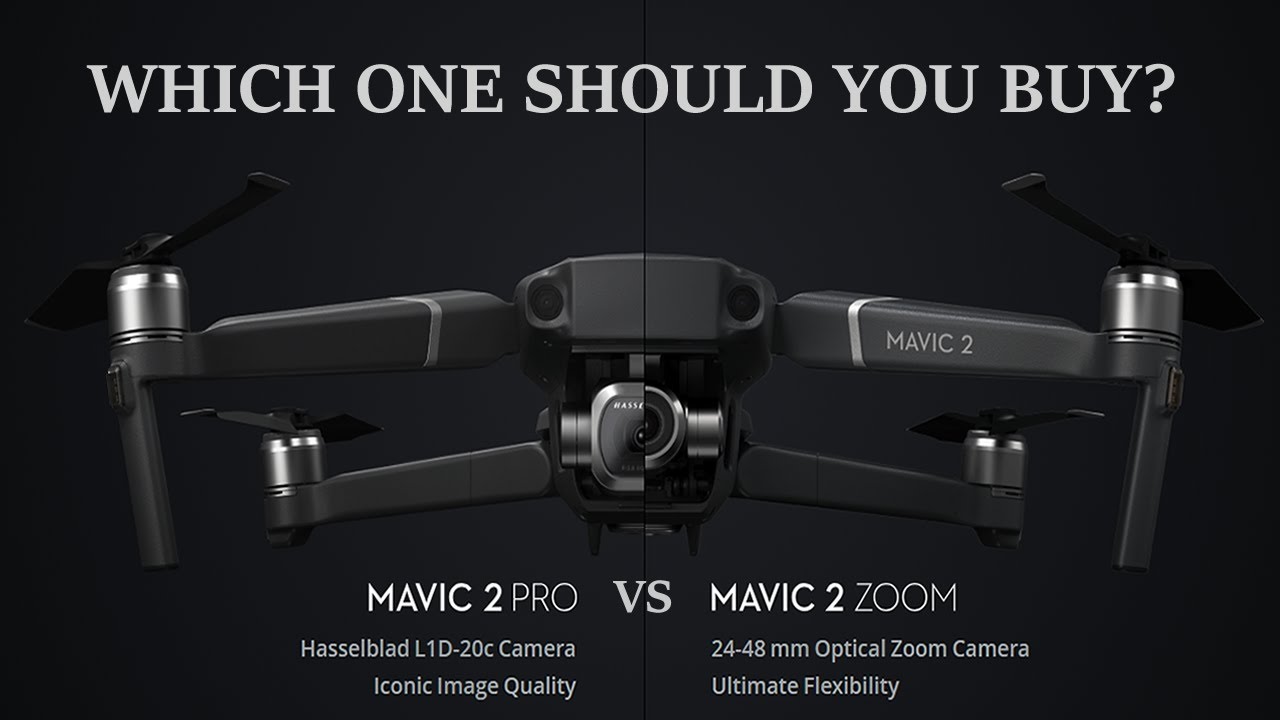
If at all there is one nit to pick here, it’s that the new Mavic is significantly, and notably larger than the predecessor.
Well, this is a surprising move especially considering how essential portability and size are to the entirety of the enterprise.
The company has also made some aesthetic adjustments in the name of making the drone more aerodynamic. The upside to this is faster speeds in that the Mavic 2 is capable of traveling at speeds of 44 miles an hour, which is pretty much zippy for such a mainstream consumer drone of its size.
In terms of form, however, not much has changed; they both look fairly identical to their older siblings, except for a few minor adjustments here and there. While this generation is slightly heavier and a little larger with a couple more sensors built into its hull, the new fleet still maintains the same awesome rock-solid construction that users will definitely love.
Features and Specifications
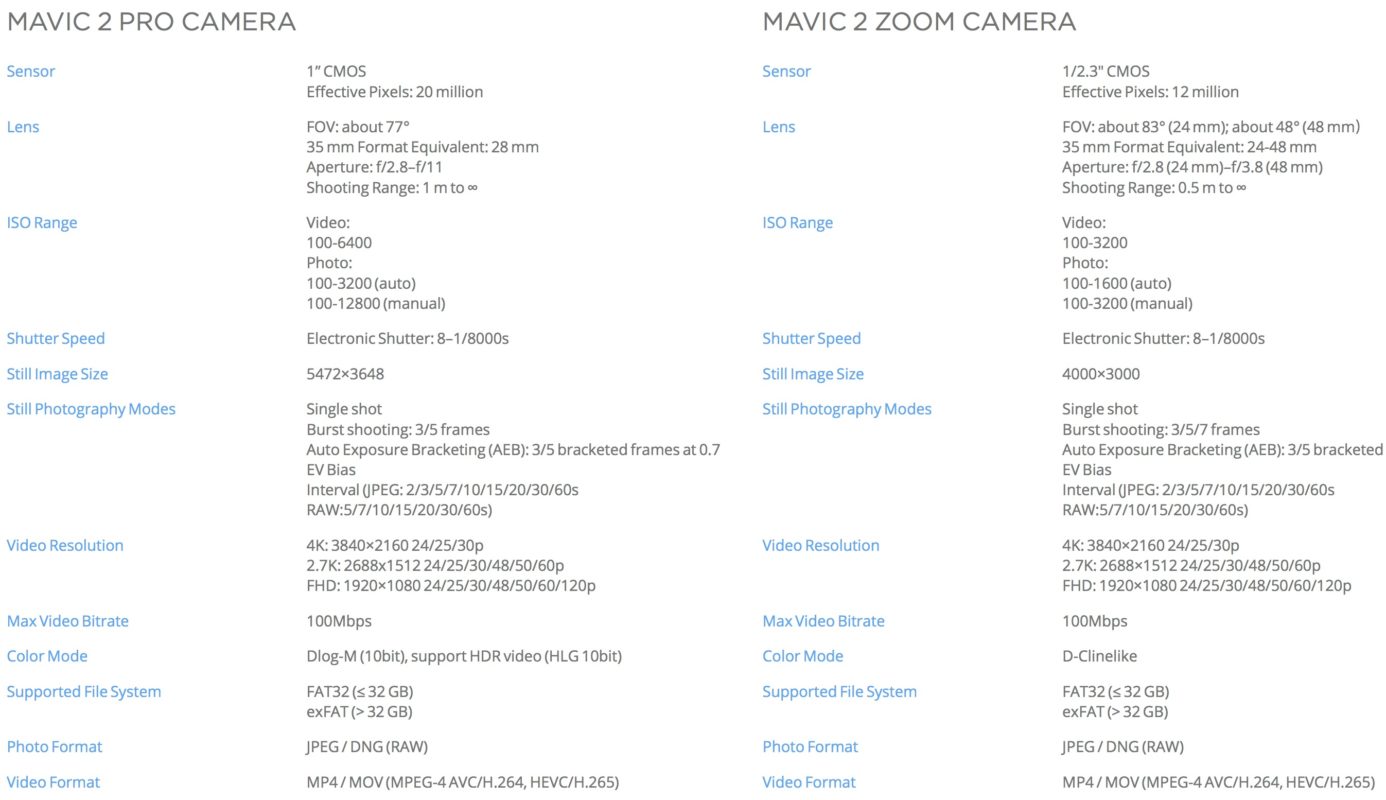
While both Mavic 2s may be based on a similar design, shooting 4K at 100mbps, there are significant differences between the sensors. The DJI Mavic 2 Pro’s Hasselblad’s camera sports a 1-inch CMOS sensor with a 10-bit D-Log M color profile that promises to capture 4 times the color depth in every channel as compared to its predecessor. It’s also designed to snap 20MP stills and allows you to adjust the aperture, which gives you some creative control that you would typically find in manual modes of dedicated land-based cameras.
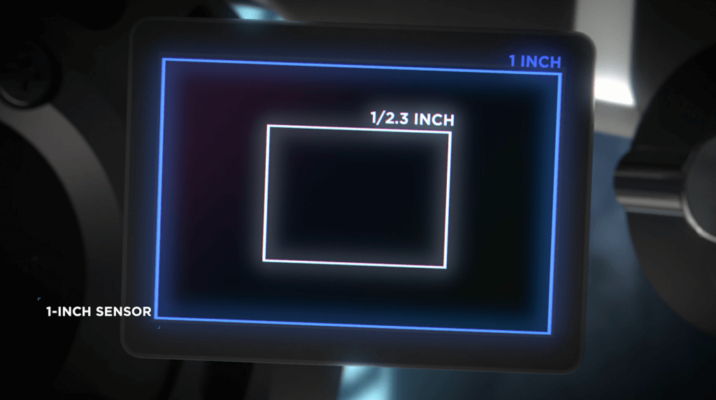
Comparatively, the Mavic 2 Zoom is more of a travel compact that combines a smaller sensor but with twice as much optical and digital zoom, giving you a 96mm telephoto lens capable of shooting lossless HD videos. While it may shoot low-resolution 12MP still, the Mavic 2 Zoom can use its optical zoom to stitch as many as 9 photos together into one 48MP image.
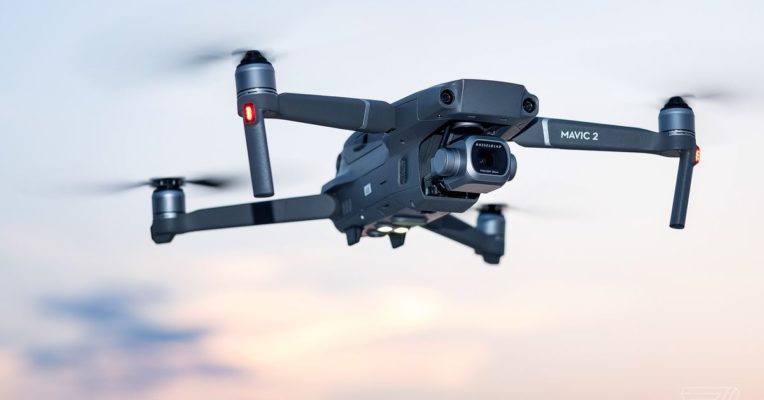
When it comes to the raw flight specs, the Mavic 2 series have not received a massive improvement to the predecessor.
They can stay airborne for a couple of minutes longer, flying a few miles per hour faster than their forebears. Areas that have seen significant improvement are the sensing abilities, software and cameras.
For the software, the Mavic 2 comes with the ActiveTrack 2.0 that allows the drone to follow moving objects autonomously, only with more precision than before. They are both equipped with OccuSync 2.0, the latest of DJI’s video transmission technology that allows you to see whatever the drone captures in real time, now in full 1080 pixels.
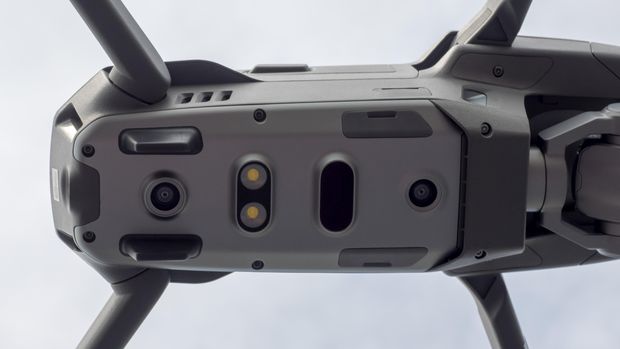
The Mavic 2s have also been outfitted with a drastically enhanced environmental-sensing system.
As compared to the original Mavic that only sensed obstacles occurring in front of it, this second generation boasts omnidirectional sense-and-avoid thanks to the 10 sensors positioned at the top, bottom, right and left of the drone. Additionally, the Mavic 2 comes with one of two amazing new cameras that include a Hasselblad. (We’ll delve into the camera specifications later).
All things considered, the Mavic 2s are more evolutionary than they are revolutionary, which in this case is a good thing.
DJI has kept so much of what worked in the original Mavic Pro, concentrating more on the areas that had significant room for improvement. That’s something every drone enthusiast will appreciate. Considering the many good things that were going on in the original Mavic, it’s good to know that DJI didn’t try to fix what wasn’t broken.
Camera Features
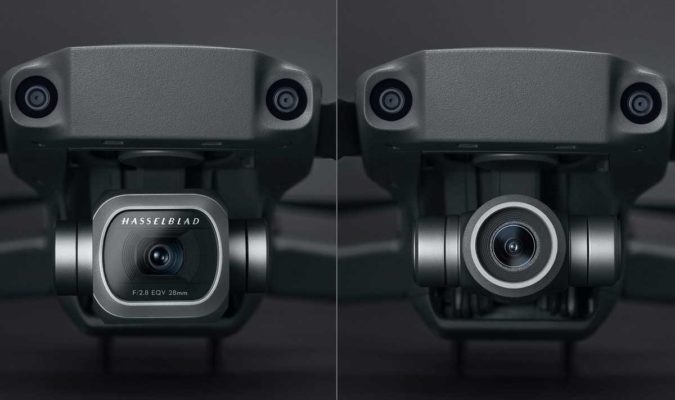
More than the original, the Mavic 2 models are focused on imaging.
As a matter of fact, so central to the update is the camera that forced the company to split the product into 2 SKUs – a Mavic Pro 2 and a Mavic 2 Zoom.
The only real distinction for the two models, however, is the front-facing camera.
Well, the branding can be a little bit confusing, perhaps, particularly considering it already has several different models. More like disappointing after a round of rumors that seemed to suggest that the company would introduce a drone with a modular gimbal, an addition that could create possibilities for swappable cameras for enthusiasts and photography professionals.
Sadly, that will have to wait for a future update.
As promised, the cameras on the Mavic 2 are rather impressive.
The Mavic 2 Pro is the first of its kind to sport a Hasselblad-branded camera following the acquisition of the legendary Swedish camera maker in 2017 by DJI (we can trust that there’s more where this came from).
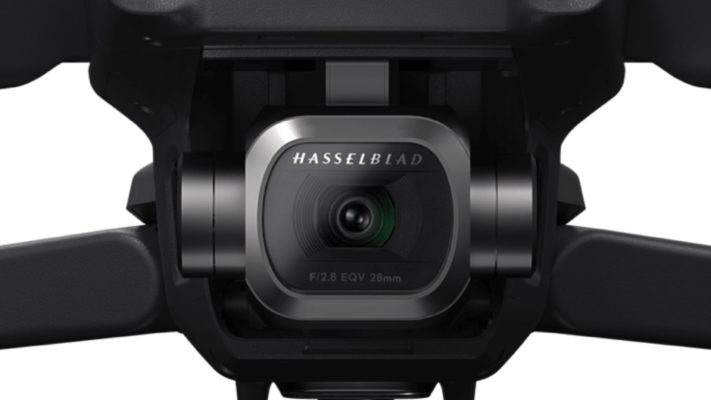
The camera comes with a 20MP 1-inch sensor but unlike Hasselblad’s standalone cameras, it has a little lag in processing yet it gets better low-light performance, better resolution and a better dynamic range.
Aperture control allows you to fine-tune the amount of light entering the camera and change the depth of field.
The shots are as great as advertised with clear and sharp pictures and an epic wide angle. For those who want nice stills or videos without having to cart a massive device around, this is a solid selection.
Casual users could probably stick to the automatic mode though for pro photographers, this is a massive feature that will greatly expand the level of creativity applied to images captured. Zooming ability is an outrageously fun feature to include in a drone.
And even though Mavic 2 Zoom’s camera might be a bit of a step-down, its 2X digital and optical zoom stimulate the effect of 96mm telephoto lenses that capture videos in the best possible resolution. This zooming ability does not just allow you to get close to your subject without flying closer, it also creates a channel to explore a bunch of creative effects.
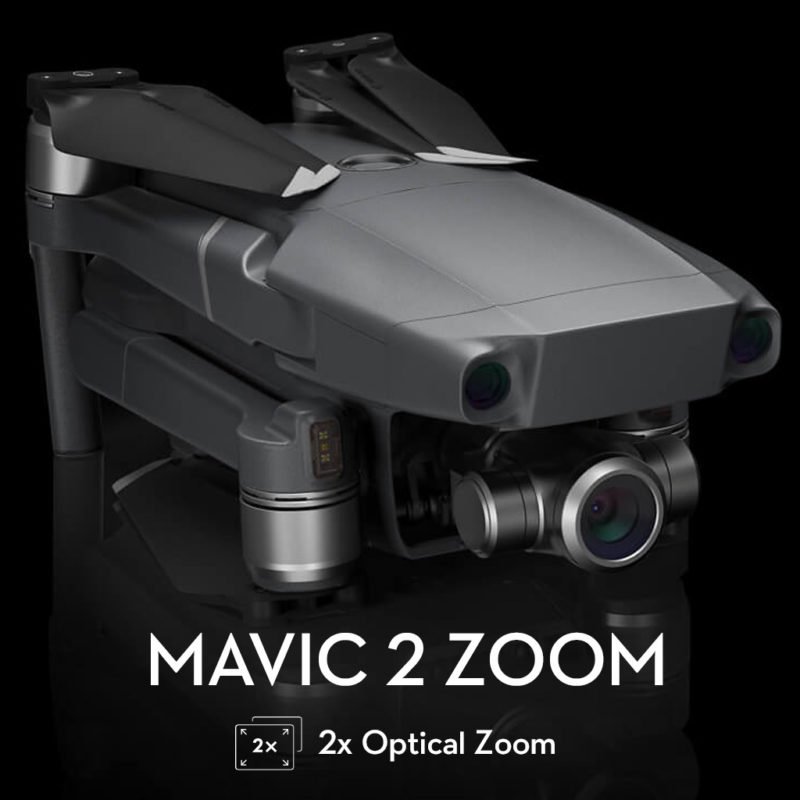
This is actually doing to be a valuable tool for most videographers as compared to the Hasselblad especially for instances where it’s hard to close in on an object for whatever reason.
An added bonus is the Dolly Zoom, a cool new mode that can zoom into an object while the drone is flying in the opposite direction, which causes a disorienting effect.
If you’ll be using the drone primarily for video, then the Mavic 2 Pro would be an ideal pick for you; but that choice can get a little tricky when it comes to photography. While the Mavic 2 Pro sports a 20-megapixel sensor, you would have better luck working with the Zoom’s 12-megapixel camera that comes with an amazing new super-resolution feature.
Overall, both Mavic 2 options come with excellent cameras, which might make choosing one over the other agonizingly difficult.
Image Quality
Beyond the camera, one would say that the update is fairly minimal over the predecessor especially considering the two-year gap. But this alone is not enough to justify a purchasing decision for those who might have used the original version.
Drones are not smartphones, so they should not be held to the same standards.
Really, just about all of the updates and upgrades are welcome. Besides their new photographic enhancements, the drones are more advanced, easier to fly and more consumer-reliant. They are an excellent pair of tools that work so well that they can fade away into the background to allow you focus on the more creative aspects they can cover rather than keeping you in constant worry over them falling off from the sky.
That aside, thanks to the Mavic Pro’s Hasselblad camera and its large 1-inch CMOS sensor, you are guaranteed noise control coupled with a lot of detail packed for post-production.
It’s capable of shooting both in H.265 and H.264 although you may only shoot true flat profiles when using H.265. The good thing about this compression system is that it has not been widely adopted yet, which means that you get to be the first few to use this feature.
Additionally, the inclusion of D-Log M means that there’s more data to work with as compared to the Cinelike profile found in the Mavic 2 Zoom.
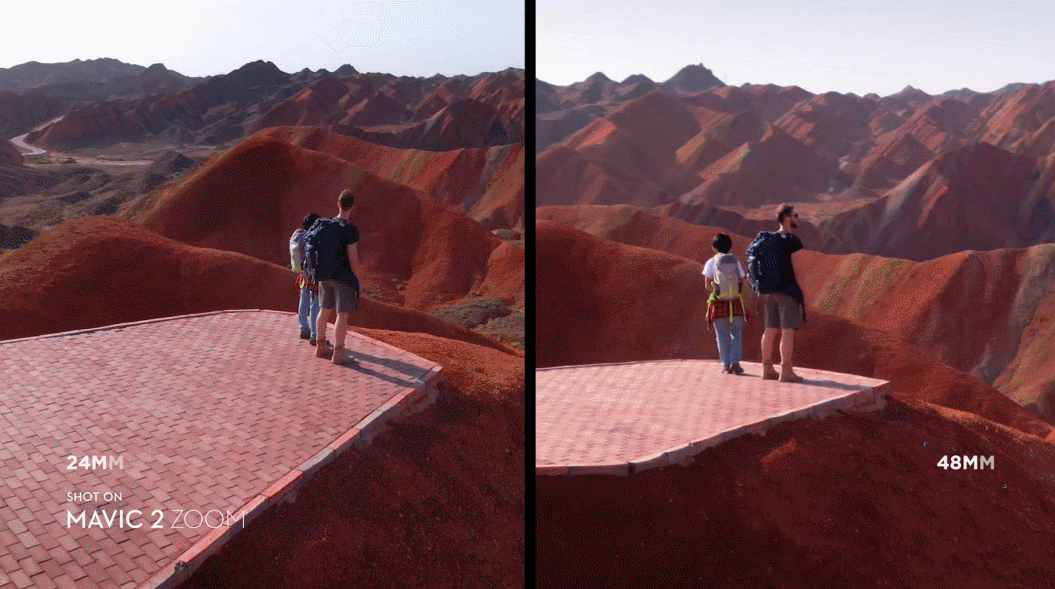
By any means, the Zoom’s resultant video footage is not that bad, but to get used to the fine-tuning settings that best fit your needs, it might take some time.
Along with a ½.3-inch sensor, it’s definitely okay to say that this is the hugest upgrade in quality from most other drones on the market. The ability to digitally and optically zoom doesn’t completely transform the way you shoot with the drone and can create shots you won’t typically see in many other drones.
The Mavic 2s are the first DJI drones that can shoot high dynamic range (HDR) footage. If you don’t want color footage in post-production, this could be a great option. Nonetheless, there is enough data retained in the 10-bit D-Log M that can allow you color images yourself for a similar effect.
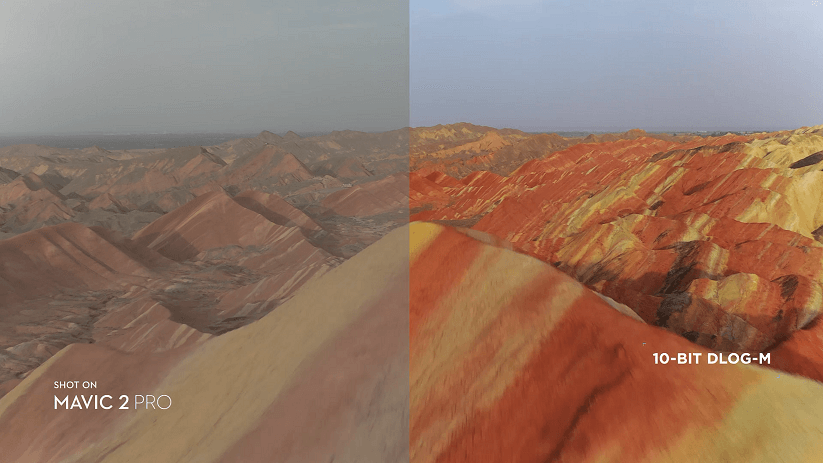
The one new mode that has been included on both models is Hyperlight, a feature that supposedly handles noise perfectly in low-light conditions.
With this, you get a significant improvement in the final image even though this doesn’t completely clean up noise-laden photos which might get a little messy in low light. Nonetheless, there are shooting modes you’re probably already well-versed with if you have used older DJI products – 360 spherical photos, vertical panoramas and horizontal panoramas.
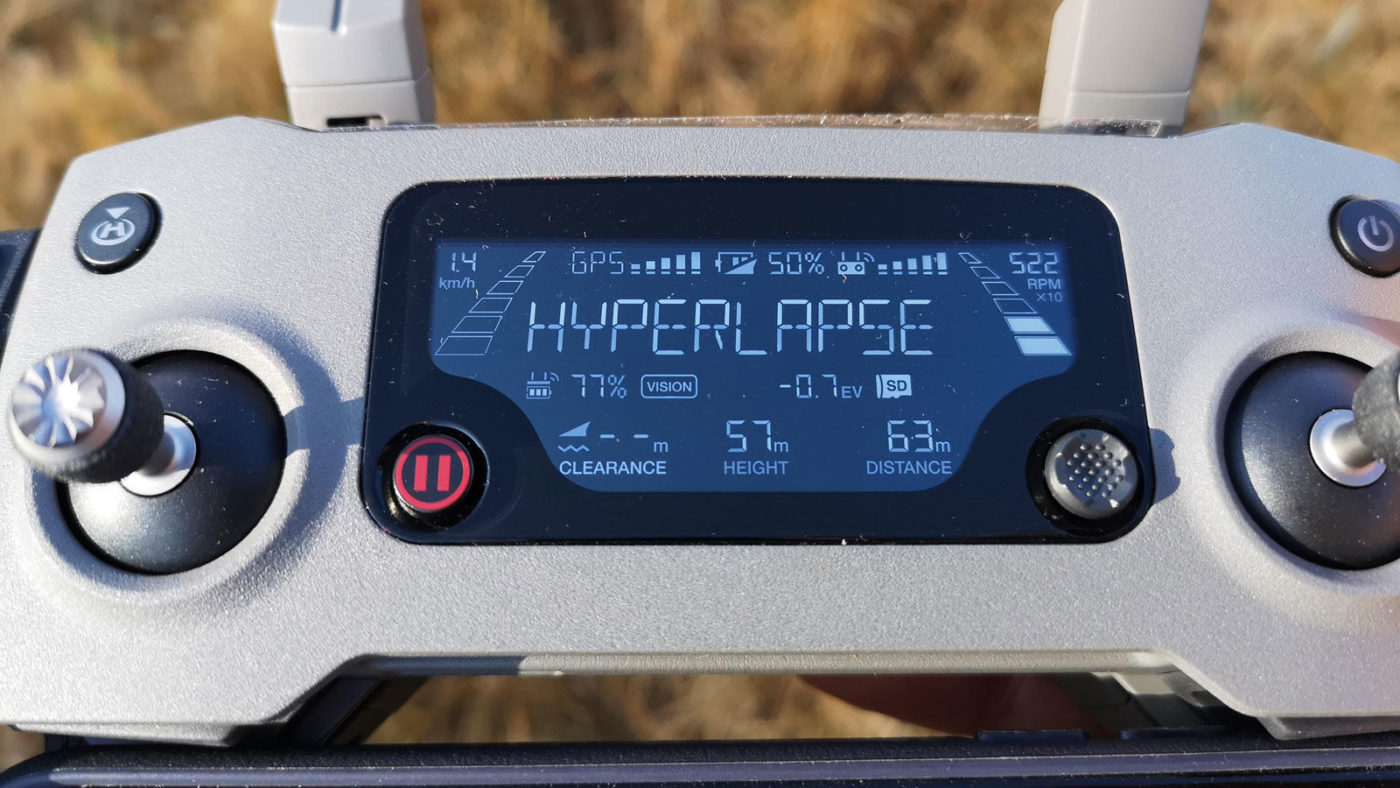
On both drones, there’s a new mode called hyperlapse that’s neatly implemented in the software.
All you have to do is select the desired length for the final video, including the intervals between which every photo should be taken and let the drone work the rest of the magic.
The hyperlapse mode also features some cool effects such as the free mode that pilots the drone manually when shooting hyper-lapse videos, circle mode that automatically flies the drone in a circular pattern around the subject in order to create a time-lapse video capturing the action, the course lock that keeps the camera fixated on a specific subject while flying in a straight direction that creates a unique perspective and the waypoint that plans a complex flight on the basis of GPS coordinates and altitude, capturing complex shots.
Unsurprisingly, these effects require a lot of time to get ideal shots.
For this reason, you can’t take them on when the battery warning starts to beep. The app might attempt it but before completing it, the drone will be forced to take an emergency landing.
The Mavic 2s enable 1080-pixel caching and previews, which means that in theory, you can edit an entire video in your smartphone. And because trust is something inevitably important when it comes to operating a drone, you can count on these for their extreme ease of use. You don’t even need to know so much about photography and videography to be able to capture excellent footage.
There are lots of autonomous shooting modes and while they may occasionally fail, the options for getting amazing shots are endless.
Plotting, Flight Control and Autonomy
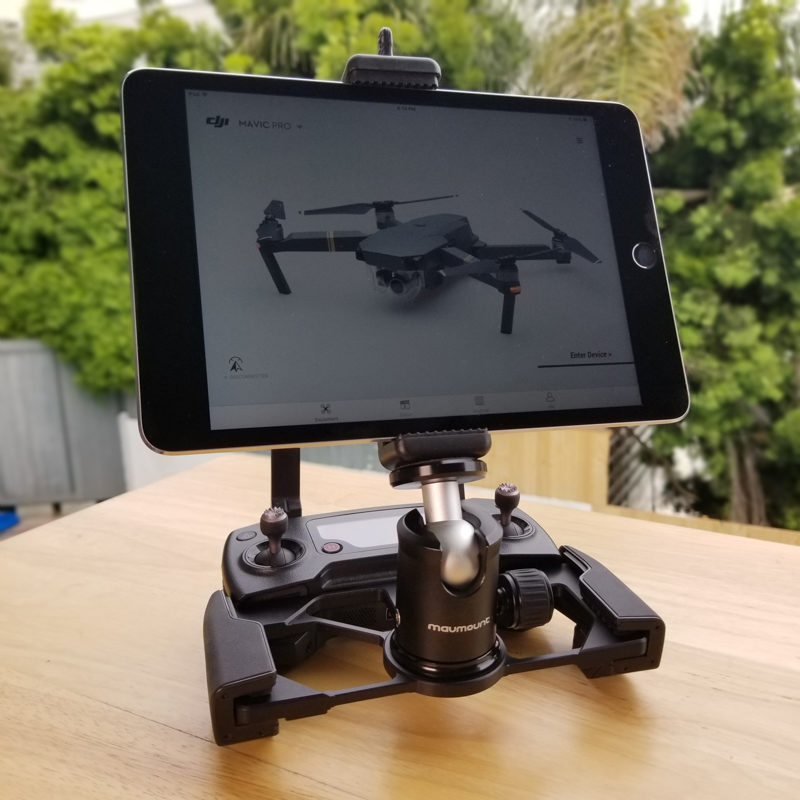
Control is pretty much similar to most other models – the controller works perfectly on Android and Apple handsets alike.
Although the actual take off process from the ground can be a bit of task, flying is very intuitive once you find your way around the different joysticks.
Once in the air, it feels just like its predecessors – supremely responsive, athletic and tight. Even if you have never flown a drone before, you’d still manage to fly these sweet gadgets like a pro. Its top-notch flight software is extremely reliable, so the Mavic will go wherever you direct it – without drifting, slippery controls or wandering.
This series of drones is practically bolted to the sky.
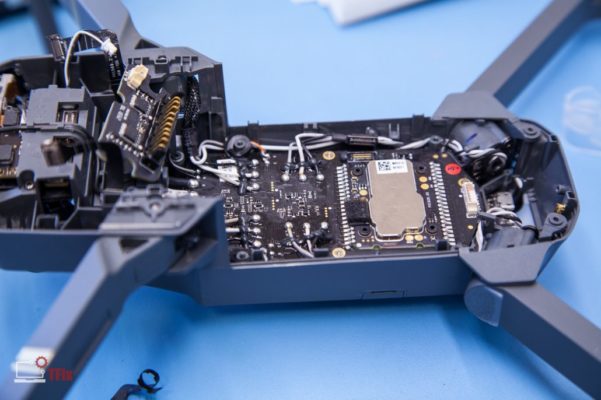
There are a couple more tweaks including an adjusted motor and raked tips on the propellers that allow the drones to fly more quietly.
Obstacle avoidance systems and on-board tracking have been adjusted. For the most part, the former is impressive enough, enabling the drone to stop in the air any time it spots something in its path.
The Mavic 2s have APAS, an amazing obstacle avoidance system that was first introduced in an earlier DJI model, which allows you to fly with so much more confidence and vigor than ever before. However, the bigger story here is the ActiveTrack 2D and 3D mapping. If say the drone gets out of your line of sight, you can use the app to track it.
The stellar manual controls are just a tip of the iceberg. The drones also sport a new version of DJI’s image transmission system, the OccuSync 2, which works flawlessly.
You will barely experience any connectivity issues when flying even when sideways sensing is disabled during manual flights. This makes the drones extremely reliable and safe – you actually have to go out of your way to crash them, and this is the kind of in-air confidence that is guaranteed to give you excellent footage.
Battery Life and Recharge Time
DJI promises that the Mavic could hover for up to 29 minutes under optimal conditions.
With its aerodynamic design, however, it can stay airborne for a while longer. Of course, you’ll need a heavier battery to support such a heavy drone, making it slightly heavier overall.
Certainly the Mavic 2 Pro is no slouch in the battery department; these drones do not run on the batteries of the old models. That notwithstanding, the company managed to squeeze some more life out of it to up its life from 28 minutes to a whopping 31 minutes for both drones.
Sure, this is not a lot, but when it comes to photography drones, every minute actually counts if it keeps the drone aloft.
The 3-minute addition makes all the difference in the world. When you’re running low on juice, the linked app notifies you, loudly.
Also, if what you want is more time, the batteries are swappable. Like flight controls, battery life is not something you will really have to worry about with this drone. It isn’t clear, though, whether there’s the possibility of charging the drones directly via USB. Yet with regards to recharging, you can expect around 45-50 minutes to juice up every battery fully, which is a little quicker than the previous generations.
Price and Release Date
Excitingly, both of these drones are now available on the DJI store.
The Mavic 2 Pro will set you back $ 1,449 coming as a bundle that includes four pairs of propellers, a charger, remote controller, battery and the drone itself. This same bundle applies to the Mavic 2 Zoom costing you $1,249.
Also available is a Fly More Kit that includes 2 batteries, carrier bag, 2 pairs of propellers, a charger and a multi-battery charging hub priced at $319.
Bottom Line
The idea behind the Mavic 2 Pro series promises that all kinds of adventurers can take professional-grade photography using a compact drone. This might probably be the reason why even though the original model had its shortcomings, the company named their first flagship product a Mavic Pro.
The Mavic 2 Pro and Mavic 2 Zoom make this proposition even more interesting by introducing interchangeable camera systems that will define every new model in the future. Combined with some nuanced yet meaningful design upgrades, this has made DJI’s latest flagship drone live up to promises made in the past.

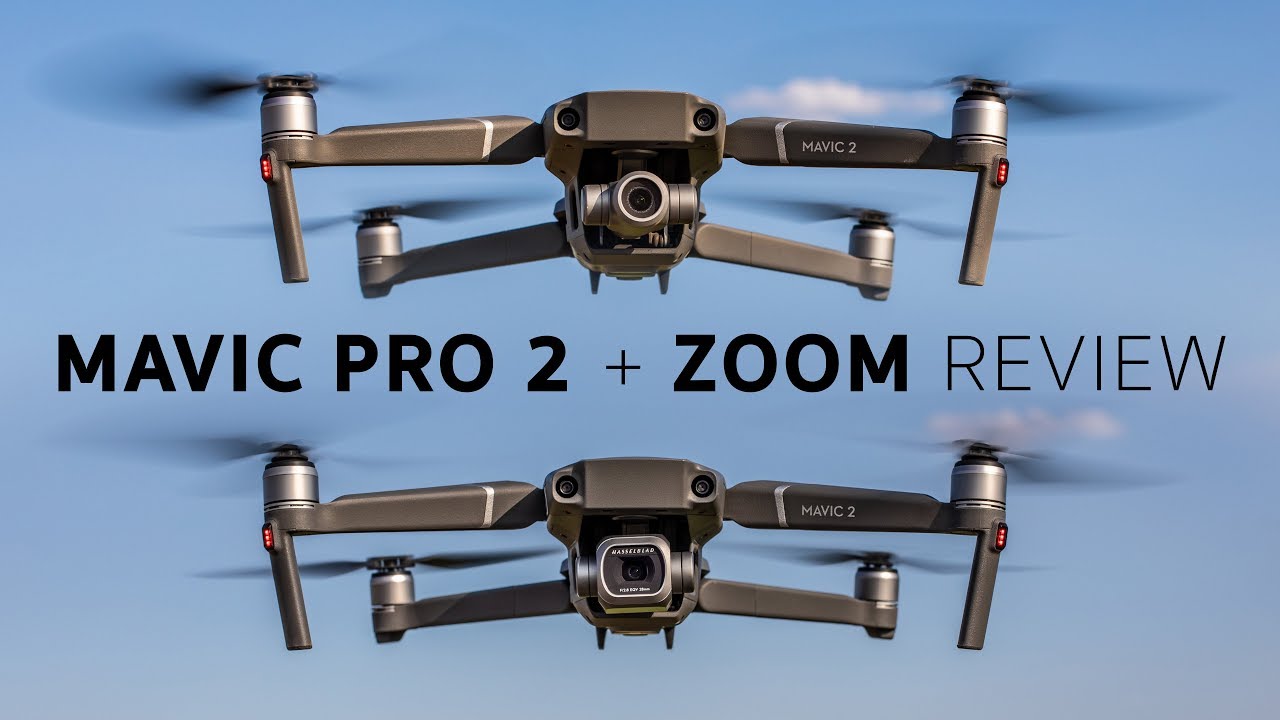
Happy flying!!!